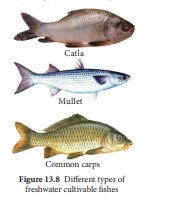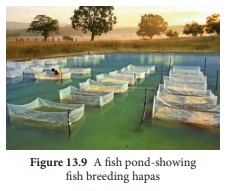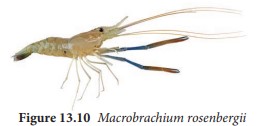Aquaculture
Aquaculture has been practiced in varying forms for centuries dating to the time of the Phoenicians. India offers a huge potential for aquaculture development. Fish culture received
notable attention in Tamil Nadu in 1911. Aquaculture is a branch of science that deals with the farming of aquatic organisms such as fish, molluscs, crustaceans and aquatic plants.
On the basis of source, aquaculture can be classified into three categories. They are (a) Freshwater aquaculture (b) Brackish water aquaculture (c) Marine water aquaculture. Culturing of fishes is called fish culture or pisciculture. Inland water bodies include freshwater bodies like rivers, canals, streams, lakes, flood plain wetlands, reservoirs, ponds, tanks and other derelict water bodies and ponds constructed for fresh water aquaculture. The pH of the freshwater should be around neutral and salinity below 5 ppt (parts per thousand).
Brackish water fishes spend most of its life in river mouths (estuaries) back
waters, mangrove swamps and coastal lagoons. Estuarine fish are more common in Bengal and Kerala. Culturing of animals in the water having salinity range 0.5 2 30 ppt are called as brackish water culture. Fishes cultured in brackish water are Milk fish (Chanos Chanos), Sea bass (‘Koduva’), Grey mullet (‘Madavai’), Pearl spots (‘Kari’meen) etc,
Marine Fisheries deal with fishing operations along seacoasts. The Indian subcontinent approximately has a 5600 kms long coastline. About 80% of India’s marine fish are supplied by the west coast and the remaining 20% by the east coast. The premier varieties are mackerels, sardines, sharks, and catfish. Marine edible fishes of Tamilnadu coast include both cartilaginous and bony fishes. Culturing of animals in the water salinity ranges from 30 - 35 ppt is called Mariculture. Some fishes like Chanos sp, Mugil cephalus are cultured here. Culturing of animals in the salinity ranges from 36 - 40 ppt is called Metahaline culture. Eg, Brine shrimp (Artemia salina). Artemia is commonly known as the brine shrimp. It is a crustacean and lives in high saline waters because of its high osmoregulatory capacity.
Fish culture Characteristics of cultivable fishes
The special characteristic features of cultivable fishes are:
i. Fishes should have high growth rate in short period for culture.
ii. They should accept supplementary diet. iii. They should be hardy enough to resist
some common diseases and infection of parasites.
iv. Fishes proposed for polyculture should be able to live together without interfering or attacking other fishes.
v. They should have high conversion efficiency so that they can effectively utilize the food.
Types of cultivable fish Cultivable fish are of 3 types(Figure 13. 8).
a. Indigenous or native fresh water fishes (Major carps, Catla, Labeo, Clarias)
b. Salt water fishes acclimatized for fresh water (Chanos, Mullet).
c. Exotic fishes or imported from other counties (Common carps)
Among these, major carps have proved to be best suited for culture in India, because the carps 1. Feed on zooplanktons and
phytoplanktons, decaying weeds, debris and other aquatic plants.
2. They can survive in turbid water with slightly higher temperature
3. Can tolerate O2 variations in water. 4. Can be transported from one place to
other easily. 5. They are highly nutritive and palatable.

External factors affecting fish culture The factors that affect fish culture are temperature, light, rain, water, flood, water current, turbidity of water, pH hardness, salinity and dissolved O2. Light and temperature also play an important role in fish breeding.
Management of fish farm To culture fish, one should have an idea about different stages of fish culture such as topographic situation, quality, source, physical, chemical and biological factors of water. Breeding, hatching, nursing, rearing and stocking fishes in ponds has to be managed properly. Keeping in view the various stages of fishes, the following different types of ponds have been recommended to manage them.
Breeding pond The first step in fish culture is the breeding of fishes, therefore, for proper breeding special types of ponds are prepared called breeding ponds. These ponds are prepared near the rivers or other natural water resources.
Types of breeding Depending on the mode of breeding, they are divided into 1.Natural breeding (Bundh breeding) These are special types of ponds where natural riverine conditions or any natural water resources are managed for breeding of culturable fishes. There bundhs are constructed in large low-lying areas that can accommodate large quantity of rain water. The shallow area of such bundhs is used as spawning ground. 2. Induced breeding The fish seed is commonly collected from breeding grounds but does not guarantee
that all fish seeds belong to the same species. Hence advanced techniques have been developed to improve the quality of fish seed by artificial method of fertilization and induced breeding. Artificial fertilization involves removal of ova and sperm from female and male by artificial mechanical process and the eggs are fertilized. For artificial fertilization the belly of mature female fish is held upward. Stripping is done with the thumb of the right hand from the anterior to posterior direction for the ejection of eggs due to force. In this way eggs are collected separately. Further, the male fish is caught with its belly downwards. The milt of fish is striped and collected separately, and then the eggs are fertilized.
Induced breeding is also done by hypophysation (removal of pituitary gland). The gonadotropin hormone (FSH and LH) secreted by the pituitary gland influences the maturation of gonads and spawning in fishes. Pituitary gland is removed from a healthy mature fish. Pituitary extract is prepared by homogenising in 0.3% saline or glycerine and centrifuged for 15 minutes at 8000rpm. The supernatant is injected intramuscularly at the base of the caudal fin or intra-peritonealy at the base of pectoral fin. Male and female fishes start to spawn (release of gametes) and eggs are fertilized. The fertilized eggs are removed from the spawning place and kept into hatching hapas.
Fish seed Fish seed is collected from breeding ponds. The spawn collecting net is commonly called Benchijal (Shooting net) and transferred to the hatching pits.
Hatching pit The fertilized eggs are kept in hatching pits. The hatching pits should be nearer to the breeding grounds, should be smaller in size with good quality water. There are two types of hatching pits, hatcheries are small sized pond in which unfertilized eggs are transferred and hatching happens. Hatching hapas are rectangular trough shaped tanks made up of mosquito net cloth supported by bamboo poles and fixed in the river (Figure 13.9).

Rearing pond Fingerlings are transferred to rearing ponds that is long and narrow and allows long distance swimming. The rearing pond should be free from toxicants and predators. Antibiotics are used for washing the fingerlings and then transferred to the stocking ponds.
Stocking pond Stocking ponds should be devoid of weeds and predatory fishes. Proper organic
manuring should be done to increase the production with cow dung and chemical fertilizing should also be done.
Harvesting Harvesting is done to capture the fishes from the water. Well grown fishes are taken out for marketing. Small sized fishes are again released into the stocking ponds for further growth. Different methods of fishing are carried out to harvest fishes. These include Stranding, Angling, Traps, Dipnets, Cast nets, Gill nets, Drag nets and purse nets. The harvested fishes are preserved by refrigeration, Deep freezing, freeze drying, sun drying, salting, smoking and canning.
Composite fish farming Few selected fishes belonging to different species are stocked together in proper proportion in a pond. This mixed farming is termed composite fish farming or polyculture. The advantages include,
- All available niches are fully utilized.
- Compatible species do not harm each other.
- No competition among different species is found.
- Catla catla, Labeo rohita and Cirrhinus mrigala are the commonly used fish species for composite fish farming.
Exotic fishes The fishes imported into a country for fish culture are called exotic fishes and such fish culture is known as exotic fish culture. Examples of such exotic fishes introduced in India are Cyprinus carpio and Oreochromis mossambicus.
Disease Management Diseases can be of viral or bacterial origin. Regular monitoring of parameters
like water quality, aeration, regular feeding, observation for mortality should be checked. Parasitic infestations and microbial infections should be observed periodically.
Economic importance of fish Fishes form a rich source of protein food and provide a good staple food to tide over the nutritional needs of man. Fish species such as sardines, mackerel, tuna, herrings have high amino acids concentrations particularly histidine which is responsible for the meaty flavor of the flesh. It is rich in fat such as omega 3 fatty acids. Minerals such as calcium, magnesium, phosphorus, potassium, iron, manganese, iodine and copper. Some of the fish by - products are:
Fish oil is the most important fish by product. It is derived from fish liver and from the fish body. Fish liver oil is derived from the liver which is rich in vitamin A and D, whereas fish body oil has high content of iodine, not suitable for human consumption, but is used in the manufacture of laundry soaps, paints and cosmetics.
Fish meal is prepared from fish waste after extracting oil from the fish. The dried wastes are used to prepare food for pig, poultry and cattle. The wastes obtained during the preparation of fish meal are widely used as manure.
Isinglass is a high-grade collagen produced from dried air bladder or swim bladder of certain fishes viz. catfish and carps. The processed bladder which is dissolved in hot water forms a gelatin having adhesive property. It is primarily used for clarification of wine, beer and vinegar.
Why are fish so efficient at converting feed to flesh?
Prawn Culture
Most important aquatic crustacean is prawn, which is widely cultured prawn flesh is palatable and rich in glycogen, protein with low fat content. Types of prawn fishery 1. Shallow water prawn fishery – located on the west coast restricted to shallow waters.
2. Estuaries and back waters or saline lake prawn fishery - The area of production of prawns are the back waters seen along the Western coast, Ennur, Pulicat, Chilka lake and Estuaries of Ganga and Brahmaputra rivers.
3. Freshwater prawn fishery - Prawns are caught from the rivers and lakes throughout India.
4. Marine prawn fishery – Most of the marine prawns are caught along the Indian coast belonging to the family Penaeidae.
Species of prawn A number of species of prawn are distributed in water resources such as Penaeus indicus, Penaeus monodon, Metapenaeus dobsoni and Macrobrachium rosenbergii.
Culture of freshwater prawn Macrobrachium rosenbergii (Figure 13.10) is commonly seen in rivers, fields and low- saline estuaries. The prawn collected from ponds, river, and paddy fields are transferred to the tanks which are aerated. For
fertilization, one pair of prawn are kept in a separate tank. After mating, the eggs are laid. Spawning tanks of different sizes should be prepared with proper aeration. Temperature (240 C – 300 C) and pH (7-8) should be maintained in the hatching tank. The eggs hatch into first and second stage larva. Artificial feed is supplied. Young ones of 5cm length (60 days old) can be reared in fresh or slightly brackish water ponds and paddy fields. Harvesting of prawns can be done twice in a year.

Preparation of farm For the preparation of ponds for algal growth and for the subsequent stocking of prawns it is essential to drain off the water and sundry the bottom followed by light tilling. Agricultural lime should be applied to absorb excess CO2 and to supply calcium which is required for moulting. Fertilizers like rice, bran, poultry, and cattle dung are used to increase the fertility of the soil. Prawns are commonly caught in crafts and gears using different types of nets such as cast nets, bag nets, drag nets, trawl nets and barrier nets. Preservation of prawns is done by peeling and deveining or by cooking and peeling.
Pearl Culture
Pearl is a white, highly shining globular concretion found within the shell of an Oyster. Pearl oysters are sedentary animals. In India it was cultured for the first time in 1973 at Thoothukudi. Pearl oysters are found along the coast of Kanyakumari and in the Gulf of Kutch. High quality pearls are obtained from pearl oysters of Genus Pinctada that can be cultured in the salinity range of 30 ppt in racks, raft and long line methods. Freshwater bivalve Lamellidens is also used in artificial pearl culture. Mostly the pearl oysters inhabit the ridges of rocks or dead corals, forming extensive pearl banks. These pearl beds produce best quality of pearls called as “Lingha Pearl”.
Pearl Formation When a foreign particle accidently enters into the space between mantle and shell of the oyster, it adheres to the mantle. The mantle epithelium encloses it like a sac and starts to secrete concentric layers of nacre around it as a defensive mechanism. Nacre is secreted continuously by the epithelial layer of the mantle and is deposited around the foreign particle and over a period time the formation of repeated layers of calcium carbonate makes the hard and glossy pearl. When the pearl enlarges the oyster dies. The shell is then carefully opened and the pearls are manually separated and graded (Figure 13. 11).
Composition of pearl Pearl comprises of water, organic matter, calcium carbonate and the residue. (1) Water: 2-4% (2) Organic matter:
3.5-5.9% (3) Calcium (4) Residue: 0.1-0.8% carbonate: 90%
Quality of pearl The pearls obtained are of variable shapes and sizes. They may be white, or cream red or pink red in colour. The spherical pearls of rainbow colour are rarely found. The best quality of pearl is obtained from marine oysters. Pearl obtained from freshwater bivalves are not as valuable as those obtained from the marine oysters (Mishra, 1961).